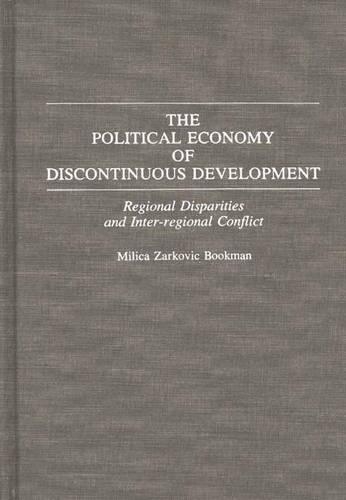
The Political Economy of Discontinuous Development: Regional Disparities and Inter-regional Conflict
(Hardback)
Publishing Details
The Political Economy of Discontinuous Development: Regional Disparities and Inter-regional Conflict
By (Author) Milica Z. Bookman
Bloomsbury Publishing PLC
Praeger Publishers Inc
30th November 1991
United States
Classifications
Tertiary Education
Non Fiction
Macroeconomics
338.9
Physical Properties
Hardback
288
Description
Outbursts of regional conflict within national boundaries have characterized recent years. Sub-national states--including parts of the Soviet Union, India, Canada, and Yugoslavia--dissatisfied with their central governments, seek forms of independence to pursue autonomous development paths. These region/state conflicts have occurred in nations at all levels of development (Canada and Indonesia, France and Papua New Guinea), under diverse economic systems (the USSR and Canada, Yugoslavia and Spain), and across political systems (federations such as India and unitary states such as Italy). Bookman's study develops methods whereby both state and region can evaluate the region's potential to sustain economic growth autonomously--filling the gap in current perceptions of inter-regional relations. Bookman introduces the concept of discontinuous development to facilitate the analysis of sub-national regions that have varying levels of development. The volume's emphasis on high-income regions within both agricultural and industrial nations and on the economic basis of conflict makes it a unique contribution that assesses the viability of regions as autonomous entities. The major part of the volume studies empirical evidence from India and Yugoslavia, especially timely in light of present ethnic and religious conflicts in both countries. The volume is divided into three sections: Foundations; Discontinuous Development and Inter-regional Conflict; and Empirical Evidence from India and Yugoslavia. The first section presents a theoretical framework for issues internal to regions, as well as regions relative to the nation. It also outlines four ways of studying inter-regional conflict which are explored in the empirical chapters. Part 2 analyzes eight high-income regions characterized by discontinuous development and relates their experiences to the four hypotheses presented earlier. The last section contains empirical chapters testing the model in the context of India and Yugoslavia. The final chapter contains a full discussion of the hypotheses pertaining to secession, and offers some suggestions concerning the possibilities of secession as the outcome of inter-regional conflict. The explosive consequences of recent trends make it imperative that scholars in development economics, political economy, political science, and macroeconomics as well as policy makers comprehend the inter-regional economic and political relationships behind these conflicts.
Reviews
This is an ambitious and unique attempt to develop a methodology by which to evaluate the potential of a region once its citizens have determined to secede from a nation, to follow an autonomous development path that will enable it to sustain at least its pre-independence level of economic growth. It is timely in that there are numerous recent examples of regional conflicts within national boundaries at various levels of development and within diverse economic systems. The analysis evolved from the integration of elements of regional science and dependency theory under conditions of discontinuous development, with most examples from India and Yugoslavia. The greater the region's ability to participate in international markets, the more self-sufficient its local economy, and the more extensive its experience in self-rule, the better are its chances to attain economic viability. On these grounds, Slovenia seems likely to be successful, while regions such as Vojvodina, Maharashtra, and the Baltic states may find it necessary to seek close ties or even integration with other national entities. Upper-division undergraduate and graduate audiences.-Choice
"This is an ambitious and unique attempt to develop a methodology by which to evaluate the potential of a region once its citizens have determined to secede from a nation, to follow an autonomous development path that will enable it to sustain at least its pre-independence level of economic growth. It is timely in that there are numerous recent examples of regional conflicts within national boundaries at various levels of development and within diverse economic systems. The analysis evolved from the integration of elements of regional science and dependency theory under conditions of discontinuous development, with most examples from India and Yugoslavia. The greater the region's ability to participate in international markets, the more self-sufficient its local economy, and the more extensive its experience in self-rule, the better are its chances to attain economic viability. On these grounds, Slovenia seems likely to be successful, while regions such as Vojvodina, Maharashtra, and the Baltic states may find it necessary to seek close ties or even integration with other national entities. Upper-division undergraduate and graduate audiences."-Choice
Author Bio
MILICA ZARKOVIC BOOKMAN is Associate Professor of Economics at St. Joseph's University in Philadelphia. She previously published Issues in Indian Agricultural Development (1987) and her numerous articles on India and Yugoslavia have appeared in Atlantic Economic Journal, Soviet Studies, and Peasant Studies, among others.
